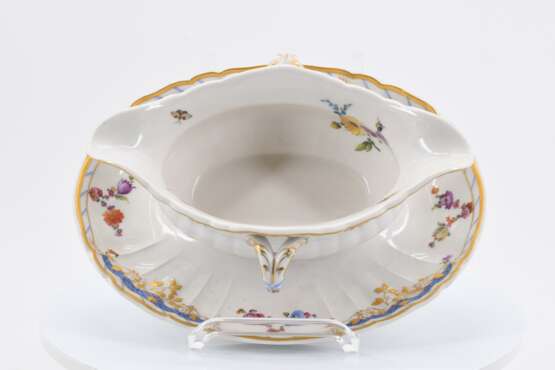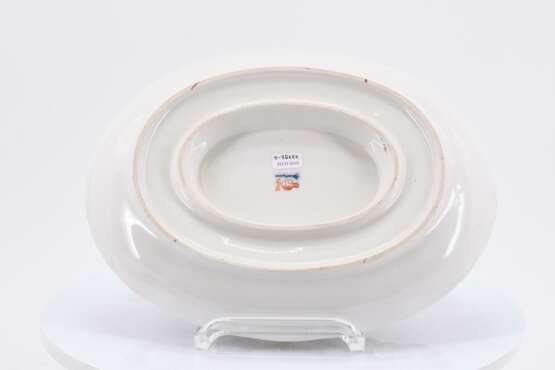ID 841943
Lot 3 | Dining service 'Breslauer Stadtschloss' for 4 Persons
Valeur estimée
€ 2 000 – 3 000
KPM. Berlin.
Date: 20th century.
Technique: Porcelain, enriched in colors and gold.
Description: In total 25 pieces consisting of:
4 plates (ø 26cm),
4 plates (ø 23cm)
4 soup bowls (h. 5,5cm)
4 saucers (ø 16,5cm)
4 bread plates (ø 15cm)
1 oval platter (31 x 24,5cm)
1 round serving bowl (ø 23cm)
1 square-shaped serving bowl (h. 4cm, 20 x20 cm)
1 sauce boat on a fixed saucer (h. 9cm, l. 25cm)
1 small round tureen (h. 19cm, ø20cm).
Mark: Scepter mark, orb in red, various painted and impressed symbols.
Literature:
-Exhibition cat. Berliner Porzellan 1763-1850, Glanz und Eleganz auf Tischen und Tafeln, Westfälischen Landesmuseum für Kunst und Kulturgeschichte Münster 2006,
Münster 2006. p.68-69, fig.56.
-Schade, Günter: Berliner Porzellan, Zur Kunst- und Kulturgeschichte der Berliner Porzellanmanufakturen im 18. Und 19. Jahrhundert, Munich, 1987. p.133-135.
The dinner service of Frederick the Great for the City Palace of Wroclaw - A highlight of Prussian dining culture
Frederick the Great had probably inherited his passion for beautiful porcelain from his mother Sophie Dorothea of Hanover, Queen of Prussia. The wife of Frederick I, the thrifty "Soldier King", was a cultivated lady who, unlike her husband, enjoyed being surrounded by luxury. In her Berlin palace "Monbijou", she organized concerts and parties and exhibited precious objects. Her collection there also included a porcelain gallery. Repeatedly she undermined the strict educational methods of her husband, set up a secret library for her son in Monbijou, allowed him to play music and to wear expensive fashion. It is probably thanks to her influence that Frederick II of Prussia went down in history not only as a successful general and brilliant statesman, but also as a littérateur, a patroniser of magnificent building projects and as a connoisseur of art and music.
Even though thriftiness, modesty and restraint were considered Prussian virtues, Frederick was drawn to the magic that emanated from porcelain as an important status symbol of the 18th century. After the Second Silesian War and the Seven Years' War, he divested the depots of the Meissen manufactory of large quantities of porcelain and decorated his residences with the precious Saxon booty. He followed attempts to establish a porcelain production in Prussia with great interest. When then the small but high-quality Berlin manufactory of Johann Ernst Gotzkowsky went bankrupt in 1763, the monarch seized the opportunity and acquired the company with his personal funds. As the trademark, he gave it the sceptre from his coat of arms, which adorns the products of the "Königliche Porzellanmanufaktur Berlin" (KPM) until today.
Until his death, Frederick was the best customer of his own manufactory and the services he commissioned were among its most important products. He ordered them to equip his palaces and he expressed clear ideas and wishes concerning the designs. The festively laid table was the centre of many courtly events and was to form an artistic unity together with the architecture and the colour scheme and furnishing of the rooms.
The production of the service for the Wroclaw City Palace started in 1767 and, with more than 7000 thalers, was the most expensive order ever placed by the King with the KPM. The decision for the shape of the plates and vessels fell on the newly developed design "Antique Zierathe", which already shows beginnings of classicistic features. The edges of the vessels are façonated, the rim is bordered by a rud bundle. Attached to this are four narrow reserves filled with a bright blue scale decor. In addition, golden tendrils, blossoms and torn flower garlands decorate the rims of the dishes. However, the focus of the design is on the central flower bouquets, typical for the Berlin manufactory. The botanical decors of the KPM indeed find their climax in this service.
From the 1770s onwards, the manufactory concentrated on floral décors that were particularly loved by the monarch and which soon established themselves as a speciality of the KPM. The lushness of Berlin's porcelain garden is unparalleled. Large, loose arrangements decorate the bodies of the tableware. The composition of the flowers is not subject to any seasonal order, but is solely committed to the dynamics and visual harmony of the arrangements. The botanical characteristics of the flowers, buds and leaves are recorded on the porcelain in great detail, which makes them seem almost alive. The diner, who sits down at a table decorated with this service, is offered a feast for the eyes that is unparalleled.
| Fabricant: | KPM - Manufacture royale de porcelaine de Berlin |
|---|---|
| Catégorie maison de vente aux enchères: | Porcelaine |
| Fabricant: | KPM - Manufacture royale de porcelaine de Berlin |
|---|---|
| Catégorie maison de vente aux enchères: | Porcelaine |
| Adresse de l'enchère |
VAN HAM Kunstauktionen GmbH Hitzelerstr. 2 50968 Köln Allemagne | ||||||||||||||
|---|---|---|---|---|---|---|---|---|---|---|---|---|---|---|---|
| Aperçu |
| ||||||||||||||
| Téléphone | +49 221 92586215 | ||||||||||||||
| Fax | +49 221 92 58 62 4 | ||||||||||||||
| Commission | 32% | ||||||||||||||
| Conditions d'utilisation | Conditions d'utilisation | ||||||||||||||
| Heures d'ouverture | Heures d'ouverture
|





















